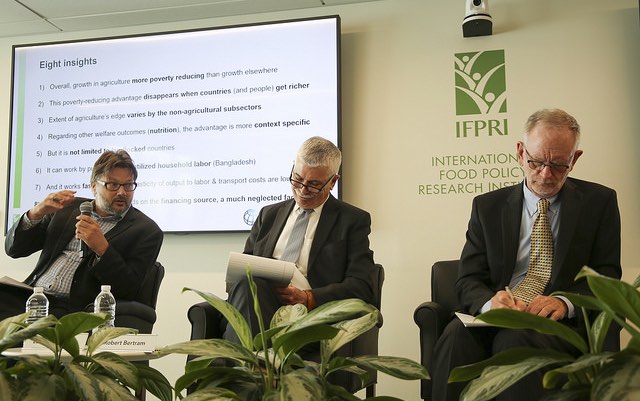Agricultural development is among the most effective tools for reducing poverty and is central to the economic growth strategies of many low-income countries. A recent special issue of World Development—edited by IFPRI Senior Research Fellow Will Martin and World Bank Lead Economist Luc Christiaensen—explores this crucial relationship between agriculture, structural transformation, and poverty reduction as it evolves under increasing globalization and urbanization.
The two researchers, along with Robert Bertram, chief scientist at the USAID Bureau for Food Security and Ian Walker, manager of the World Bank Jobs Group, discussed agricultural development and its impact on job quality and the livelihoods of the poor at an IFPRI policy seminar Oct. 22.
In the early 2000s, the notion that agricultural development could contribute to poverty reduction was controversial, Christiaensen said. But subsequent research in individual countries and across borders has confirmed that relationship, helping to make agriculture a key part of the poverty reduction agenda.
The special issue of World Development discussed in the seminar digs deeper into this important dynamic with new data, focusing on the conditions that fuel growth and poverty reduction, and on the policies and financing needed to foster growth.
“These eight papers confirm that growth in agriculture is generally more poverty-reducing than the same amount of GDP growth generated elsewhere,” said Christiaensen.
This outsized impact of agricultural growth on poverty is not universal. Christiaensen noted it declines and disappears as countries and people get richer. Some researchers also believe that because agricultural growth has lagged in Africa south of the Sahara, that it does not have a large impact on job creation and poverty reduction. Instead, they argue that greater trade openness is the key driver of poverty reduction.
But Martin explained why, in general, the connection is robust.
“The two main reasons why agriculture is particularly potent as a channel for poverty reduction are that agriculture is labor intensive in developing countries, and food consumption shares are very high for the poorest people,” Martin said.
As employment and agricultural productivity rise, there may be positive and negative effects for stakeholders, Martin said. At constant prices, farmers’ net income from farming rises as their output increases. If food prices fall—as they do when innovations are widely adopted in a market—consumers’ purchasing power increases, with these benefits being greatest for the poorest consumers; many small, poor farmers are net buyers of food and so benefit from both the increase in productivity and the decline in prices; but some farmers who are net sellers may lose from lower prices.
Increased agricultural productivity also raises wages for unskilled workers—an important source of gain for many poor, landless workers. One study in the special issue, by Emran and Shilpi, found that a 1 percent increase in yields in Bangladesh causes rural wages to go up by 0.9 percent, labor supply to go up by 0.4 percent, and consumption to increase by 0.5 percent.
Bertram noted that agriculture-driven poverty reduction has both direct and indirect beneficiaries. He stressed the challenges of moving very poor people out of poverty, as their circumstances vary by factors including gender or local resources. Rather than figuring out ways to get poor, unemployed people involved in farming, Bertram suggested that it would be better for researchers and policy makers to identify which jobs would most help the poorest, like those without land. Off-farm employment may be a better option, he said. Bertram said he was encouraged by findings in the study that trade, transport, and agro-processing were effective at reducing poverty while improving food systems.
The rising demand for high-quality foods in Africa also offers considerable economic promise, he said.
“It is an existential challenge for Africa’s producers to provide the needs for Africa’s cities and towns, where you have growing demand for quality, diversified foods. Those are nutritious foods, helping consumers improve their health, and providing great opportunities for farmers to raise their incomes,” Bertram said.
Walker, the moderator, said it’s also important to monitor which non-agricultural sectors are growing and the difference they make in poverty reduction. For instance, he said, the World Bank tracks which sectors labor is shifting into—whether informal services with low productivity, similar to that in agriculture; or formal services with higher marginal productivity. Understanding this composition is vital to recognizing the job opportunities that will further catalyze poverty reduction.
Maxwell Young is an IFPRI Communications Specialist.







